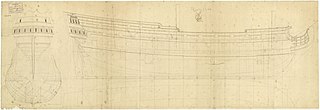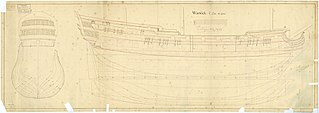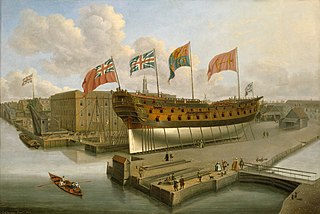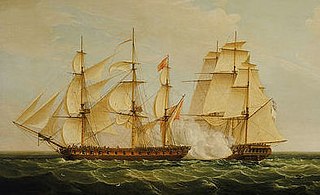
Admiral of the Blue Edward Boscawen, PC was a British Admiral in the Royal Navy and Member of Parliament for the borough of Truro, Cornwall, England. He is known principally for his various naval commands during the 18th century and the engagements that he won, including the siege of Louisburg in 1758 and Battle of Lagos in 1759. He is also remembered as the officer who signed the warrant authorising the execution of Admiral John Byng in 1757, for failing to engage the enemy at the Battle of Minorca (1756). In his political role, he served as a Member of Parliament for Truro from 1742 until his death although due to almost constant naval employment he seems not to have been particularly active. He also served as one of the Lords Commissioners of the Admiralty on the Board of Admiralty from 1751 and as a member of the Privy Council from 1758 until his death in 1761.

Admiral John Byng was a British Royal Navy officer who was court-martialled and executed by firing squad. After joining the navy at the age of thirteen, he participated at the Battle of Cape Passaro in 1718. Over the next thirty years he built up a reputation as a solid naval officer and received promotion to vice-admiral in 1747. He also served as Commodore-Governor of Newfoundland Colony in 1742, Commander-in-Chief, Leith, 1745 to 1746 and was a member of Parliament from 1751 until his death.

The naval Battle of Lagos took place between a British fleet commanded by Sir Edward Boscawen and a French fleet under Jean-François de La Clue-Sabran over two days in 1759 during the Seven Years' War. They fought south west of the Gulf of Cádiz on 18 August and to the east of the small Portuguese port of Lagos, after which the battle is named, on 19 August.

Captain Sir Alexander Schomberg was an 18th-century Royal Navy officer.

The Foudroyant was an 80-gun ship of the line of the French Navy. She was later captured and served in the Royal Navy as the Third Rate HMS Foudroyant.

HMS Modeste was a 64-gun third rate ship of the line of the Royal Navy. She was previously the 64-gun Modeste, of the French Navy, launched in 1759 and captured later that year.

HMS Kingston was a 60-gun fourth-rate ship of the line of the Royal Navy, built by Frame in Hull and launched on 13 March 1697. She had an eventful career, taking part in numerous engagements.

HMS Warwick was a 60-gun fourth-rate ship of the line of the Royal Navy, built to the 1719 Establishment at Plymouth by P. Lock. The keel was laid down on 1 April 1730, and the ship was launched on 25 October 1733, and completed on 24 August 1734.

HMS Buckingham was a 70-gun third-rate ship of the line of the Royal Navy, built at Deptford Dockyard by John Holland to the draught specified by the 1745 Establishment, and in active service during the Seven Years' War with France. With a crew of 520 she was one of the largest ships in the Navy at that time.

Terrible was originally a 74-gun ship of the line of the French Navy launched in 1739. Captured on 14 October 1747, she was taken into Royal Navy service as the third rate HMS Terrible.

HMS Monarch was originally the 74-gun ship of the line Monarque of the French Navy launched in March 1747. Captured on 14 October 1747, she was taken into Royal Navy service as the third rate HMS Monarch.
The French brig Alerte was launched in April 1787. The Royal Navy captured her at Toulon in August 1793, and renamed her HMS Vigilante. The British set her on fire when they evacuated Toulon in December of that year. After the French rebuilt her as Alerte, she served at the Battle of Aboukir Bay. The British recaptured her in June 1799 and took her into service as HMS Minorca. Minorca was sold in 1802.

HMS Active was a 28-gun Coventry-class sixth-rate sailing frigate of the Royal Navy, launched in 1758. She was one of the captors of the Spanish ship Hermione. After Hermione surrendered, her captors found that she carried a large cargo of gold and silver that would lead to the greatest single amount of prize money awarded to the crew of a British warship.
James Young was an officer of the Royal Navy who saw service during the War of the Austrian Succession, the Seven Years' War and the American War of Independence, rising to the rank of admiral of the white.

The action of 29 April 1758 was a naval engagement fought in the Bay of Biscay near Brest between a British Royal Navy squadron and a single French Navy ship of the line during the Seven Years' War. In an attempt to support the garrison of Louisbourg, who were facing an impending siege, the French Atlantic Fleet sent a number of squadrons and ships to sea during the spring of 1758. To intercept these ships, Royal Navy squadrons maintained a close blockade of their main port at Brest. In April a British squadron including HMS Intrepid, HMS Dorsetshire and HMS Achilles was cruising off the French Biscay Coast when a lone sail was sighted to the southwest. Dorsetshire, commanded by Captain Peter Denis was sent to investigate, discovering the ship to be the French ship of the line Raisonnable sailing to Louisbourg. In a fierce battle, Dorsetshire managed to inflict heavy casualties on the French ship and force her captain, Louis-Armand-Constantin de Rohan, to surrender.

HMS Pearl was a fifth-rate, 32-gun British Royal Navy frigate of the Niger-class. Launched at Chatham Dockyard in 1762, she served in British North America until January 1773, when she sailed to England for repairs. Returning to North America in March 1776, to fight in the American Revolutionary War, Pearl escorted the transports which landed troops in Kip's Bay that September. Much of the following year was spent on the Delaware River where she took part in the Battle of Red Bank in October. Towards the end of 1777, Pearl joined Vice-Admiral Richard Howe's fleet in Narragansett Bay and was still there when the French fleet arrived and began an attack on British positions. Both fleets were forced to retire due to bad weather and the action was inconclusive. Pearl was then despatched to keep an eye on the French fleet, which had been driven into Boston.

HMS Dolphin was a 44-gun fifth rate ship of the Royal Navy launched in 1781. Designed by Sir Thomas Slade, she carried her armament on two decks and had a main battery of 18-pound long guns. She made an appearance at the Battle of Dogger Bank in 1781. The rest of her 36-year career was uneventful, much of it being spent as a transport or hospital ship, armed only with twenty or twenty-four, 9-pounders. She was broken up at Portsmouth in 1817.

HMS Swallow was a 14-gun Merlin-class sloop of the Royal Navy. Commissioned in 1745, she initially served in home waters as a convoy escort and cruiser before sailing to join the East Indies Station in 1747. There she served in the squadron of Rear-Admiral Edward Boscawen, taking part in an aborted invasion of Mauritius and the Siege of Pondicherry. In 1755 Swallow returned home to join the Downs Station, as part of which she fought at the Raid on St Malo, Raid on Cherbourg, and Battle of Saint Cast in 1758. She was also present when the French fleet broke out of Brest prior to the Battle of Quiberon Bay in 1759.

The Perseverance-class frigate was a 36-gun, later 42-gun, 18-pounder fifth-rate frigate class of twelve ships of the Royal Navy, constructed in two batches. Designed by Surveyor of the Navy Sir Edward Hunt the first iteration, consisting of four ships, was constructed as a rival to the similar Flora-class frigate. Strongly built ships, the Perseverance class provided favourable gunnery characteristics and was highly manoeuvrable, but bought these traits with a loss of speed. The name ship of the class, Perseverance, was ordered in 1779 and participated in the American Revolutionary War, but her three sister ships were constructed too late to take part. The class continued in service after the war, but soon became outdated.

Rear-Admiral Sir Thomas Hardy was a Royal Navy officer of the late seventeenth and early eighteenth centuries. Having joined the navy sometime before 1688, Hardy became a follower of George Churchill, to whom he served as first lieutenant during the Battles of Barfleur and La Hougue in 1692. Promoted to post-captain in 1693, Hardy served in the Channel Islands and off the coast of England until 1702 when he was given command of HMS Pembroke off the coast of Spain. Having fought at the Battle of Cádiz, he subsequently discovered the location of the Franco-Spanish fleet through the intervention of his chaplain, which resulted in the Battle of Vigo Bay. Hardy was knighted for his services.


















